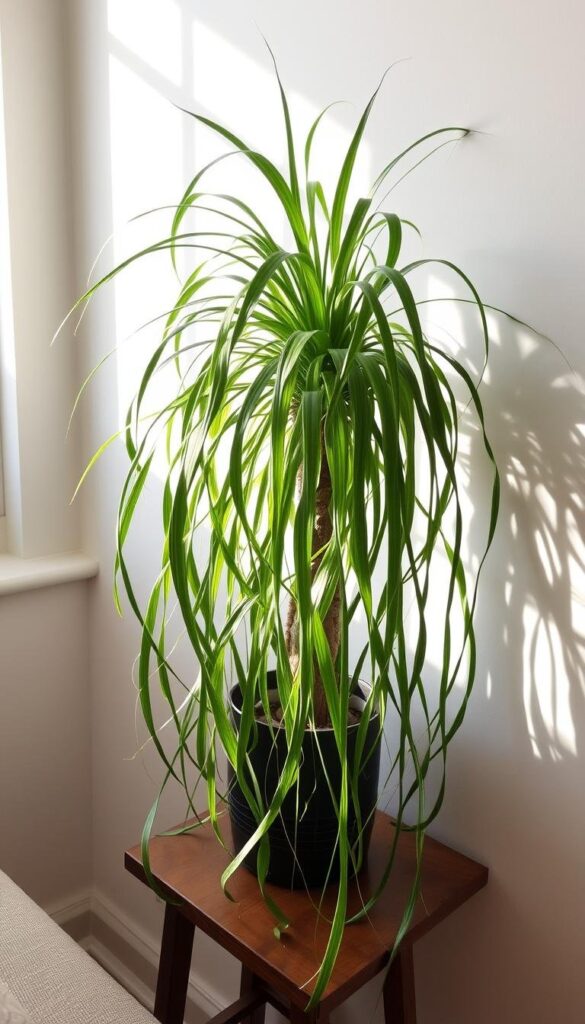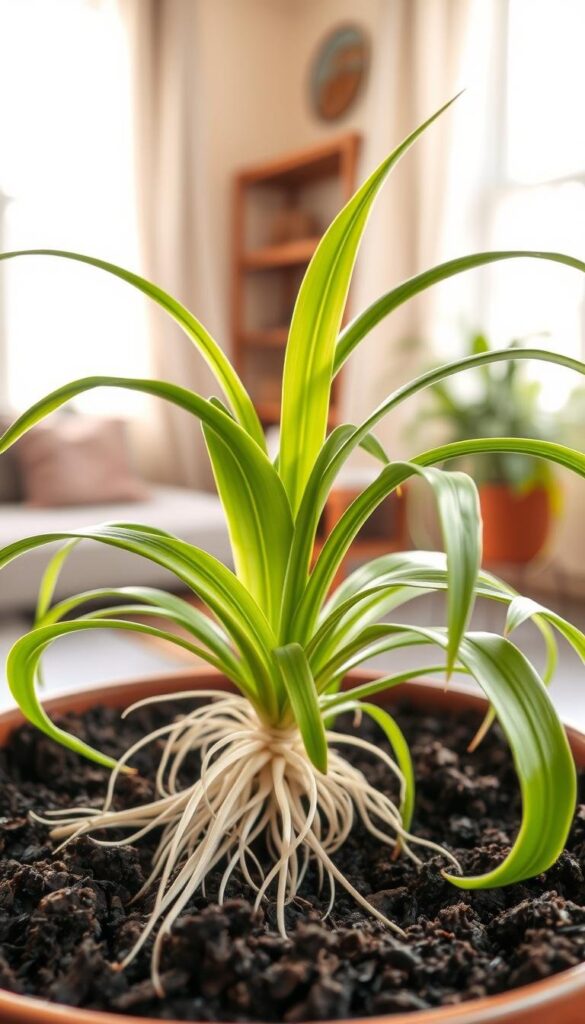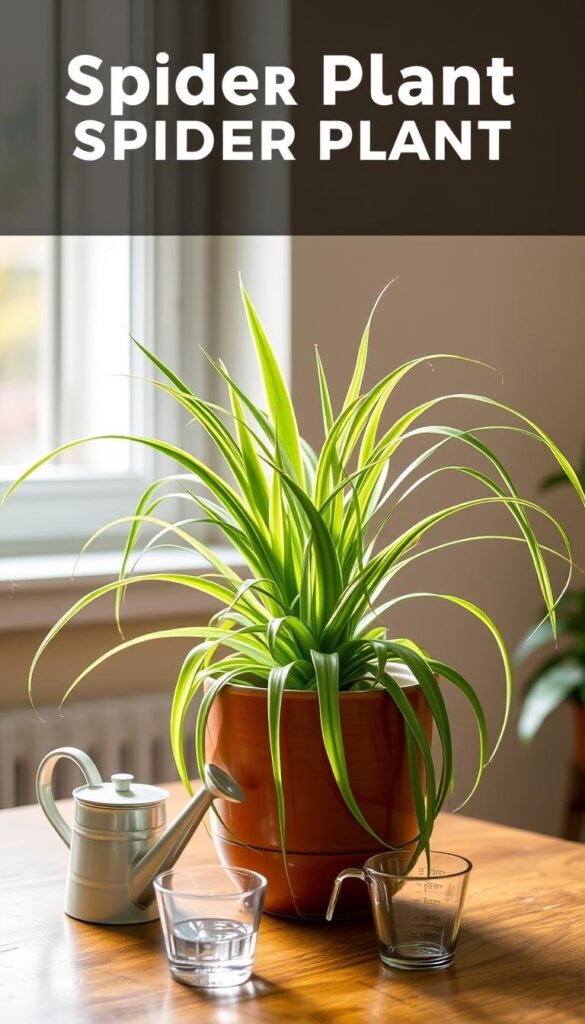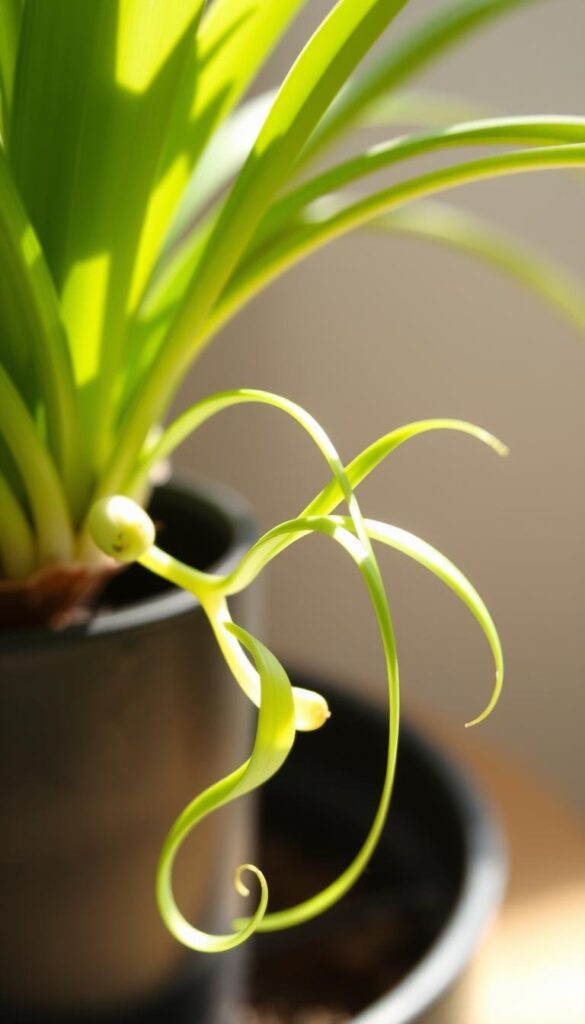This post may contain affiliate links. If you click and buy, we may earn a small commission at no extra cost to you. Learn more.
Spider Plants are loved for being easy to care for. As someone who loves plants, I’ve seen how well they do with the right care. This guide will share my best tips to help your Spider Plant grow well, whether you’re new to gardening or have experience.
Learn all about Spider Plant care, from the basics to advanced techniques. We’ll cover what they need in terms of light, water, and soil. Plus, find out creative ways to show off these versatile plants. Let’s make your Spider Plant the highlight of your home!
Contents
- 1 What is a Spider Plant?
- 2 Benefits of Spider Plants
- 3 Ideal Growing Conditions
- 4 Watering Your Spider Plant
- 5 Propagation Techniques
- 6 Common Pests and Problems
- 7 Fertilizing Your Spider Plant
- 8 Pruning and Grooming
- 9 Repotting Your Spider Plant
- 10 Spider Plant Toxicity
- 11 Decorating with Spider Plants
- 12 Fun Facts About Spider Plants
- 13 FAQ
- 13.1 What are the light requirements for Spider Plants?
- 13.2 How often should I water my Spider Plant?
- 13.3 How can I propagate my Spider Plant?
- 13.4 What type of soil is best for Spider Plants?
- 13.5 Are Spider Plants safe for pets?
- 13.6 What are the signs of overwatering Spider Plants?
- 13.7 How can I prune my Spider Plant effectively?
- 13.8 How do I know when it’s time to repot my Spider Plant?
- 13.9 Can Spider Plants adapt to different humidity levels?
- 13.10 What are some creative ways to display Spider Plants?
What is a Spider Plant?
Spider Plants (Chlorophytum comosum) are loved for their toughness and beauty. They come from warm, humid places in Africa. For over a century, they’ve brightened homes, starting on Victorian windowsills.

Overview and Origin
From South Africa to tropical Africa, Spider Plants live in grasslands. They became popular in Europe in the 1800s. Now, they’re cherished for being easy to care for and clean the air.
Unique Features
Spider Plants have long, thin leaves that curve outwards. Their standout feature is the “spiderettes” that hang like tiny plants. These plantlets grow on long stems, making it easy to share the plant. Their leaves, with green and white stripes, bring a tropical feel to any space.
Common Varieties
Discover the most popular Spider Plant varieties:
| Variety | Leaf Pattern | Notable Trait |
|---|---|---|
| ‘Vittatum’ | White-striped green leaves | Most common variety; thrives in indirect light |
| ‘Bonnie’ | Curly green edges with cream centers | Unique curly leaf shape |
| ‘Ocean’ | Solid dark green leaves | No variegation; ideal for modern decor |
Choose your favorite Spider Plant varieties based on leaf style and space. Each variety is great for indoor spaces, perfect for both new and experienced plant lovers.
Benefits of Spider Plants
Spider Plants are more than just pretty—they’re powerful houseplants. They make spaces healthier and more welcoming. I’ve seen how they change places for the better.

Air Purification Capabilities
One of their best features? Spider Plant benefits include clean air. NASA’s Clean Air Study showed they remove toxins like formaldehyde and xylene. This means you can breathe easier while enjoying their beauty!
Their leaves act as natural air filters. They’re great for kitchens or offices.
Low Maintenance Requirements
- Thrives in indirect light but survives in low light
- Forgives missed waterings (wait until soil is dry)
- Resists pests better than finicky houseplants
They’re like a low-key best friend—no drama, just dependability. I’ve seen one come back to life after weeks of neglect!
Aesthetic Appeal
Spider Plants bring style effortlessly. Their arching leaves and dangling “pups” create beautiful green sculptures. They fit any style, from boho to minimalist.
Their trailing habit makes them stand out in window sills or bookshelves.
“A Spider Plant’s simplicity is its superpower.”
From purifying the air to thriving on neglect, it’s clear why they’re loved by many.
Ideal Growing Conditions
To grow a healthy Spider Plant, you need to know its basic needs. We’ll look at how light, temperature, and soil help your plant thrive.
Light Requirements
Spider Plants need bright, indirect light but can handle lower light too. Place them near windows that face east or north for the best growth. Direct sunlight can burn their leaves, while too little light can dull their colors.
If the leaves start to turn mostly green, it’s a sign they need more light.

“Spider Plants prioritize consistency—steady indirect light and consistent drainage are their golden rules.”
Temperature and Humidity
Keep the temperature between 65–75°F for the best growth. These plants can handle average home humidity but enjoy a monthly misting in dry places. Make sure they’re not too close to heaters or drafty windows.
Soil Recommendations
Spider Plants don’t like wet feet. Use a well-draining soil mix to prevent root rot. A good mix is 2 parts peat moss, 1 part perlite, and 1 part sand. You can also use Bonide Houseplant Potting Soil for a quick fix.
Make sure the soil holds moisture but drains fast.
- Avoid heavy clay soils that trap water
- Test soil pH: slightly acidic (6.0–7.0) is ideal
By adjusting these factors, your Spider Plant will stay healthy and vibrant all year.
Watering Your Spider Plant
Getting the watering right is key to thriving Spider Plant care. Let me share my method to avoid common mistakes. Here’s how to keep your plant happy and hydrated without guesswork.

Frequency of Watering
Water when the top inch of soil feels dry. In spring and summer, that’s about once a week. In winter, water every 2–3 weeks. Always check soil moisture before pouring water in—this avoids overwatering disasters.
Signs of Overwatering
- Yellowing leaf tips or entire leaves
- Mushy stems or a sour soil smell
- Browning leaf edges paired with soft, limp foliage
Signs of Underwatering
- Crunchy, crispy leaf edges
- Wilting even with adequate light
- Slow growth or drooping plant posture
| Overwatering Symptoms | Underwatering Symptoms |
|---|---|
| Yellow leaves, root rot | Brittle leaves, dry soil |
| Mold on soil surface | Wilting despite moist soil |
Avoid fluoridated water—it can cause brown tips. Let tap water sit overnight to evaporate chemicals. For best results, water thoroughly until it drains out the bottom, then empty the saucer to prevent sitting water. Adjust based on your home’s humidity and light levels!
Propagation Techniques
Spider Plant propagation is a fun way to grow new plants easily. These plants do well through two main methods: dividing mature clumps or rooting their dangling plantlets. Let’s explore how to do both successfully.

Division Method
Here’s how to split a crowded Spider Plant:
- Unpot the plant gently during repotting season.
- Inspect the root ball and separate sections with their own set of roots and shoots.
- Plant each division in fresh soil, water thoroughly, and keep in bright, indirect light.
New growth emerges in 4–6 weeks. I recommend dividing in spring for best results.
Plantlets Method
Turn those tiny plantlets into full plants with these steps:
- Snip a healthy plantlet from the stem once it’s 3–4 inches long.
- Submerge the cut end in water for 1–2 weeks until roots appear, or plant directly in soil.
- Once roots form, transplant to a small pot and care like an adult plant.
I’ve seen plantlets root in 2 weeks, but soil-grown ones take longer. Avoid overwatering to prevent root rot. Both methods let you share your Spider Plant with friends!
Common Pests and Problems
Even hardy Spider Plants face challenges. Regular Spider Plant care helps prevent issues, but knowing how to spot and solve problems is key. Let’s break down the most common threats and how to handle them.
Identifying Common Pests
Check leaves often for these culprits:
- Spider mites: Tiny dots on undersides, causing yellowing leaves.
- Aphids: Clusters near stems, leaving sticky residue.
- Mealybugs: White cotton-like patches on foliage.
Wipe leaves with a damp cloth or use insecticidal soap for mild infestations.
Disease Management
Bacterial or fungal issues like leaf spot or root rot need quick action. For Spider Plant care tips, remove affected leaves and adjust watering. Use a fungicide if root rot strikes—repot in fresh soil after trimming damaged roots.
Preventative Measures
Prevention beats cure. My top Spider Plant care strategies include:
- Space plants to improve airflow.
- Inspect weekly for early pest detection.
- Avoid overwatering to stop root rot.
“An ounce of prevention stops a pound of problems.”
Brown leaf tips? Check humidity levels—they thrive in 40-60% humidity. Filtered water helps reduce fluoride damage. Stay proactive, and your plant will stay healthy for years!
Fertilizing Your Spider Plant
Fertilizing is a key part of Spider Plant care but needs a gentle touch. Let’s break down the essentials for healthy growth without the guesswork.
Best Types of Fertilizers
Choose the right nutrients to keep your plant thriving:
- Opt for balanced, water-soluble fertilizers like 10-10-10 NPK diluted to half strength.
- Controlled-release pellets offer slow, steady feeding without frequent applications.
Frequency and Timing
Stick to a seasonal routine:
- Feed every 4–6 weeks during spring and summer when growth is active.
- Skip fertilizer in fall and winter when the plant rests.
Adjust based on your plant’s environment—shadier spots may need less frequent feeding.
Over-fertilizing causes root burn, showing as brown leaf tips. Yellow leaves? That’s a sign of nutrient deficiency. Always water before feeding to avoid root shock. How to care for Spider Plant growth peaks with patience and moderation.
Pruning and Grooming
Pruning is more than just making your plant look good. It’s a key part of Spider Plant care tips that helps your plant stay healthy. By trimming regularly, you remove dead parts and encourage new growth. Let’s explore how to make every cut count.
When to Prune
Timing is everything. Prune in spring or early summer when your plant is growing fast. Look for brown edges or yellow tips on leaves to know it’s time. Also, trim when spiderettes get too long. But, don’t prune in winter when growth slows down.
How to Prune
Use clean, sharp shears or scissors. Here’s how I do it:
- Trim brown leaf tips with a diagonal cut near the base.
- Snip yellow leaves at the soil line to prevent rot.
- Cut back overgrown stems by one-third to shape the plant.
- Remove excess spiderettes to focus energy on the main plant.
After pruning, gently wipe leaves with a damp cloth to remove dust. Rotate the pot weekly for even sunlight. This simple Spider Plant care routine keeps your plant full and healthy.
Repotting Your Spider Plant
Knowing when and how to repot your Spider Plant is key to its long-term health. Let’s break down the process so you can handle it like a pro.
Signs It’s Time to Repot
Watch for these clues that your plant needs more space:
- Roots poking through drainage holes or crowding the pot
- Soil drying out within a day of watering
- Yellow leaves despite proper Spider Plant care
Step-by-Step Repotting Guide
- Choose a new pot 1-2 inches wider in diameter than the current one
- Use fresh Spider Plant soil mixed with perlite for drainage
- Gently loosen roots and remove old soil before placing in the new pot
- Fill gaps with fresh soil, leaving ½ inch below the rim
- Water thoroughly after repotting to settle the soil
Avoid overpotting—never jump more than 2 inches in size at once. Aftercare matters: keep the plant in indirect light for 2-3 weeks. Most Spider Plants only need repotting every 1-2 years when young, slowing as they mature. A quick tip from experts: “Check roots annually by gently tapping the pot to assess rootball size.”
“Repotting during spring ensures your plant has time to adjust before slower winter growth.”
Following these steps keeps your Spider Plant thriving for years to come.
Spider Plant Toxicity
Rest easy knowing Spider Plant safety is a breeze. These plants are not toxic, but curious cats might nibble leaves. This is because they contain compounds similar to catnip. Most pets only get a mild stomach upset, not serious harm.
Safe for Pets and Children?
All Spider Plant varieties are safe, according to the ASPCA. Cats might show interest, leading to drooling or excitement. To keep both safe, try these tips:
- Place plants out of easy reach
- Offer cat grass as a safer chew option
- Rinse leaves if nibbled to remove dust
Symptoms of Poisonment
If a pet eats the plant, watch for these signs:
| Symptom | Action |
|---|---|
| Upset stomach | Remove plant fragments |
| Increased drooling | Provide fresh water |
| Loss of appetite | Monitor for 24 hours |
If symptoms don’t go away, call a vet. Always keep Spider Plant leaves clean to avoid ingestion risks.
Decorating with Spider Plants
Spider Plants are great for decorating any space. Their leaves and spiderettes fit well in modern or cozy rooms. Here are some styling tips:
Incorporating into Home Décor
Match Spider Plants with your home’s style. For a bohemian look, choose terracotta pots and woven stands. Modern homes look good with white planters.
My top tip is to hang Spider Plant Bonnie above bookshelves. It adds a soft touch to sharp corners.
Creative Display Ideas
- Hang clusters in grouped macramé hangers
- Stack pots on tiered shelves
- Float rooted cuttings in glass containers
| Spider Plant Variety | Pair With | Container Style |
|---|---|---|
| Vittatum | Boston ferns | Wooden ladder shelves |
| Variegatum | Succulent collections | Concrete planters |
| Bonnie | Monstera plants | Metal wall planters |
Use trailing plants to fill corners or balance big furniture. Mix different Spider Plant varieties for texture. They’re perfect for busy areas, keeping your space looking good.
Fun Facts About Spider Plants
Let’s end this guide with some fun facts about Spider Plants. Did you know they have a rich history as fascinating as their green leaves?
Historical Significance
Spider Plants come from South Africa and were used in traditional medicine. They became popular in the 1800s for their air-purifying qualities. By the 1970s, they symbolized eco-awareness.
NASA studies in the 1980s showed they filter toxins. This made them even more popular.
Cultural Symbolism
In many cultures, Spider Plants stand for resilience and family. They’re also known as “Mother’s Plant” because of their plantlets. Modern research shows they clean the air, reducing harmful chemicals.
From African homes to today’s living spaces, they’re more than just plants. They represent adaptability and care.
FAQ
What are the light requirements for Spider Plants?
Spider Plants do best in bright, indirect light. They can handle lower light too. But, less light might slow their growth and reduce color.
How often should I water my Spider Plant?
Water your Spider Plant once a week when it’s growing. Make sure the soil is dry before watering again. In winter, you might water less often.
How can I propagate my Spider Plant?
You can grow new Spider Plants in two ways. First, you can divide an old plant when you repot it. Second, you can root the baby plants in soil or water.
What type of soil is best for Spider Plants?
Spider Plants like soil that drains well and is slightly acidic. Mixing regular potting soil with perlite or sand is a good choice.
Are Spider Plants safe for pets?
Yes, Spider Plants are safe for pets and kids, according to the ASPCA. But, cats might find them a bit exciting, like catnip. So, watch your cats around them.
What are the signs of overwatering Spider Plants?
Overwatering shows up as yellow leaves, root rot, and soft roots. Make sure your pot drains well and let the soil dry out between waterings.
How can I prune my Spider Plant effectively?
To prune, cut off brown tips and yellow leaves with sharp scissors. This keeps your plant bushy and looking neat.
How do I know when it’s time to repot my Spider Plant?
Repot when roots come out of the pot, growth slows, or soil dries too fast. You usually need to repot every 1-2 years.
Can Spider Plants adapt to different humidity levels?
Yes! Spider Plants can handle different humidity levels well. They prefer moist air, so mist them in dry seasons.
What are some creative ways to display Spider Plants?
There are many ways to show off Spider Plants! Hang them in planters for a waterfall effect. Use stands for height or add them to vertical gardens.
To bring you cozy inspiration more efficiently, we sometimes use AI to assist in content creation — but every word and idea is carefully shaped by our team. See our AI Disclosure for more info.







